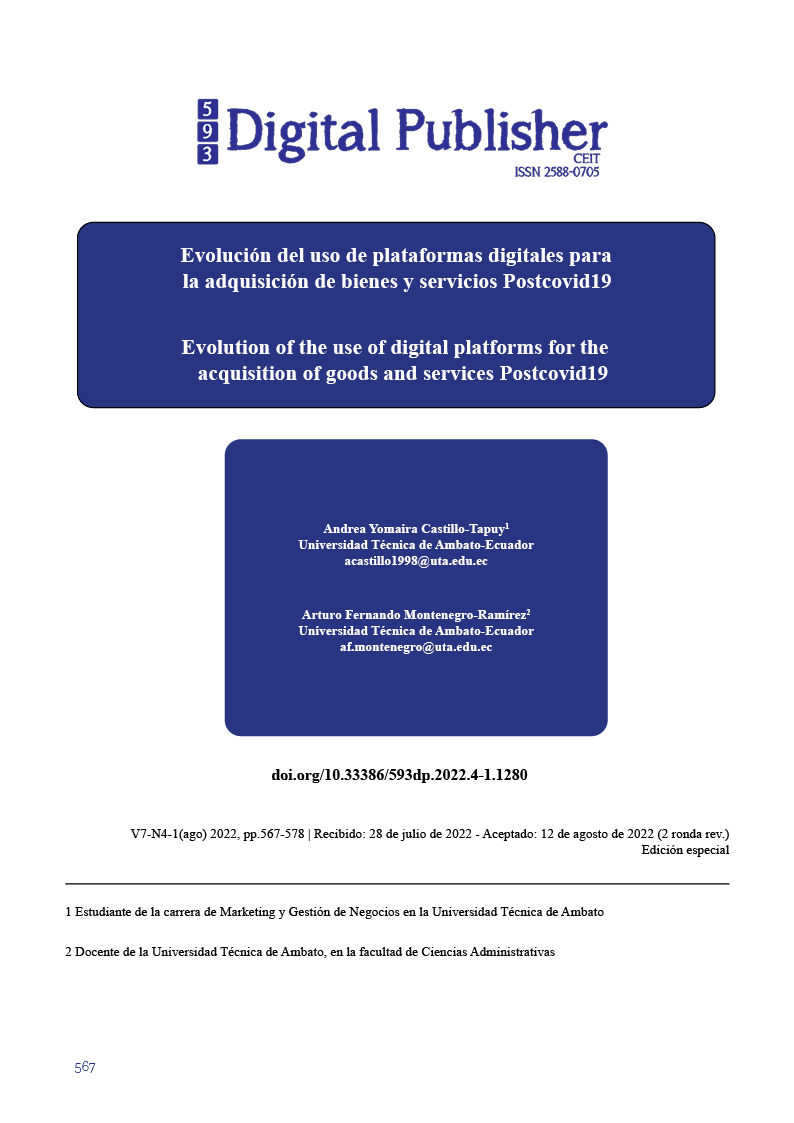Evolution of the use of digital platforms for the acquisition of goods and services Postcovid19
Main Article Content
Abstract
The current world is still in a health, social, and of course economic emergency, with a high level of uncertainty, many economies are closed and paralyzed, there are still quarantines and restrictions. Covid-19 has challenged the global socioeconomic system and in the same way Ecuadorian companies, which, because of the pandemic, have had to rethink their business model, mainly applying digital strategies, and the use of digital platforms for their transactions. commercial and the acquisition of goods and services with safe mechanisms and efficient tools, which causes a search for new strategies to balance their activities. Through a bibliographic review, this article aims to have a global and national vision of the evolution of digital platforms and their impact on the marketing of post-pandemic goods and services. Now, due to the ease of cost and accessibility, the trend is to take advantage of electronic transactions and digital technology to guarantee production, sustain the demand for goods and services, and avoid the paralysis of supply chains and their operations. It is concluded that the use and exploitation of virtual resources such as websites and mobile applications guarantee security in transactions, commercial interaction, and management in the management of multimedia digital objects, setting a positive impact on the way of doing business and the commercialization of goods and services.
Downloads
Article Details

This work is licensed under a Creative Commons Attribution-NonCommercial-ShareAlike 4.0 International License.
1. Derechos de autor
Las obras que se publican en 593 Digital Publisher CEIT están sujetas a los siguientes términos:
1.1. 593 Digital Publisher CEIT, conserva los derechos patrimoniales (copyright) de las obras publicadas, favorece y permite la reutilización de las mismas bajo la licencia Licencia Creative Commons 4.0 de Reconocimiento-NoComercial-CompartirIgual 4.0, por lo cual se pueden copiar, usar, difundir, transmitir y exponer públicamente, siempre que:
1.1.a. Se cite la autoría y fuente original de su publicación (revista, editorial, URL).
1.1.b. No se usen para fines comerciales u onerosos.
1.1.c. Se mencione la existencia y especificaciones de esta licencia de uso.
References
Aguerre, C. (2019). Digital trade in Latin America: mapping issues and approaches. Digital Policy, Regulation and Governance, 21(1), 2-18.
Anzules, B., & Bajaña, N. (2020). El uso del comercio electrónico y su incidencia en la rentabilidad de las Pymes del norte de Guayaquil . Guayaquil : Universidad Laica Vicente Rocafuerte de Guayaquil . Obtenido de http://repositorio.ulvr.edu.ec/handle/44000/3769
Banco Mundial. (2018). Indicadores de Desarrollo Mundial, Exportaciones de combustible. Obtenido de https://datos.bancomundial.org/indicator/TX.VAL.FUEL.Z S.UN
Banco Mundial. (2019a). Indicadores de Desarrollo Mundial. Banco Mundial. Obtenido de https://datos.bancomundial.org/indicador/SP.POP.TOTL?name%20desc=false
Banco Mundial. (2019b). Indicadores de Desarrollo Mundial. Banco Mundial. Obtenido de https://datos.bancomundial.org/indicador/NY.GDP.MKTP.CD
BID. (2020). Banco Interamericano de Desarrollo informe anual 2020: Estados financieros. BID. Obtenido de https://www.iadb.org/es
Branch. (2021). Estadisticas de la situacion digital de Ecuador en el 2020 2021. Branch. Obtenido de https://branch.com.co/marketing-digital/estadisticas-de-la-situacion-digital-de-ecuador-en-el-2020-2021/#:~:text=Ecuador%20tiene%2010.17%20millones%20usuarios,trav%C3%A9s%20de%20su%20dispositivo%20m%C3%B3vil
Castro, J. (2015). Comercio Electrónico COE. Recuperado el 15 de 11 de 2020, de Evolución y Futuro del Comercio Electrónico: http://www.esi.uclm.es/www/jjcastro/coe/evolucion.html
CECE. (2018). Ecommerceday. Quito. Obtenido de http://www.ecommerceday.ec/2018/
CEPAL. (2021). La era de las plataformas digitales y el desarrollo de los mercados de datos en un contexto de libre competencia. Naciones Unidas: Naciones Unidas, Santiago. Obtenido de https://repositorio.cepal.org/bitstream/handle/11362/47540/1/S2100764_es.pdf
CIPPEC. (2018). Ciudad Digital. BID.
Correa, A. P. (2020). Estrategias de E-Commerce basado en el modelo de toma de decisiones para PYMES dedicadas a servicios gastronómicos del cantón Babahoyo. Doctoral dissertation. Obtenido de http://181.39.139.68:8080/handle/123456789/1024
Doménech, G. (2015). La regulación de la economía colaborativa. El caso Uber contra el taxi. Revista práctica de Derecho, 175, 61-104.
FCE. (18 de 11 de 2020). Qué es una página web. Obtenido de www.empremdelo.es: http://www.madrid.org/cs/StaticFiles/Emprendedores/GuiaEmprendedor/tema7/F49_7.9_WEB.pdf
Fernández, J. (2018). El valor del comercio electrónico en el siglo XXI. Cuautitlan Izcalli: Universidad Autonoma de México. Obtenido de http://ri.uaemex.mx/bitstream/handle/20.500.11799/98823/Tesina%20de%20JJ.pdf;jsessionid=C409C3DA5EC9A2B6F609F56A3993B37A?sequence=3
Flores, L., & Ormachea, K. (2022). Importancia de comercio virtual empresarial y su relación con la tecnología digital. Peru: Universidad Autónoma San Francisco. Obtenido de http://repositorio.uasf.edu.pe/handle/UASF/734
FMI. (2020). Perspectivas Económicas: Las Américas. La persistencia de la pandemia nubla la recuperación. Washington: FMI. Obtenido de https://www.imf.org/-/media/Files/Publications/REO/WHD/2020/Oct/Spanish/texts.ashx
Forbes. (2016). Así fue como PayPal se hizo de 6 millones de usuarios en AL. Obtenido de https://www.forbes.com.mx/asi-fue-como-paypal-se-hizo-de-6-millones-de-usuarios-en-al/
García, J. (2018). La regulación del comercio: retos ante el cambio tecnológico. Revista del Instituto de Ciencias Jurídicas de Puebla, 12(41), 43-70.
Gob.ec. (2002). Ley de Comercio Electrónico,firmas electrónicas y mensajes de datos. Obtenido de R.O. Suplemento 557 Año III: https://www.gob.ec/regulaciones/2002-67-ley-comercio-electronico-firmas-mensajes-datos
Granda, J. (2020). Las Pymes y el manejo de los estados financieros en la cuidad de Machala. Machala-El Oro: Universidad Técnica de Machala. Obtenido de http://repositorio.utmachala.edu.ec/bitstream/48000/13051/1/ECUACE-2018-CA-DE00927.pdf
Hernández, B. (27 de 03 de 2021). Esto es lo que una red wifi puede hacer por la educación en la pandemia. El Pais. Obtenido de https://elpais.com/planeta-futuro/2021-03-28/esto-es-lo-que-una-red-wifi-puede-hacer-por-la-educacion-en-la-pandemia.html
Hofman, A., Mas, M., Aravena, C., & Guevara, J. (2017). Crecimiento economico y productividad en Latinoamerica. El proyecto LA-KLEMS. El trimestre economico, 84(334), 259 - 306. doi: https://dx.doi.org/10.20430/ete.v84i334.302
Interbrand. (2019). https://www.interbrand.com/best-brands/best-global-brands/2018/ranking/ebay/#. Obtenido de https://www.interbrand.com/best-global-brands/?filter-sort=DESC
Kawa, A., & Wojciech, Z. (2016). Conception of integrator in Cross-Border E-Commerce . Logforum, 12(1). doi:10.17270/J.LOG.2016.1.6
Mentinno. (2020). Estado digital Ecuador 2020. Recuperado el 15 de 12 de 2020, de Estadísticas digitales actualizadas: https://blog.formaciongerencial.com/estadodigitalecuador2020/
Mentinno. (Julio de 2021). Estado Digital Ecuador Actualización Julio 2021. Obtenido de https://www.mentinno.com/estadodigitalecuador/#descarga
Mentino. (202). ESTADO DIGITAL ECUADOR 2022 – ESTADÍSTICAS DIGITALES. Ecuador: Mentino. Obtenido de https://blog.formaciongerencial.com/estado-digital-ecuador-2022-estadisticas-digitales/
Mentino. (2021). Tendencias digitales de Ecuador 2021 - 2025. Ecuador. Obtenido de https://www.mentinno.com/tendenciasdigitales/#descarga
MINTEL. (2019). Ecuador Digital. Quito. Obtenido de https://www.telecomunicaciones.gob.ec/wp-content/uploads/2019/05/PPT-Estrategia-Ecuador-Digital.pdf
Mintel. (2020). Agenda Digital Andina. Obtenido de https://www.telecomunicaciones.gob.ec/wp-content/uploads/2022/05/AGENDA-DIGITAL-ANDINA-HOJA-DE-RUTA.pdf
Molina, F., & Rodriguez, G. (2017). Model for digital evidence preservation in criminal research institutions-PREDECI. nternational Journal of Electronic Security and Digital Forensics,, 9(2), 150-166. doi:https://doi.org/10.1504/IJESDF.2017.083989
Molina-Granja, F., Yánez, R., & Cabezas, E. (2016). IT Governance—Models and Application. New Advances in Information Systems and Technologies, 467-480. Obtenido de https://link.springer.com/chapter/10.1007/978-3-319-31232-3_44
Muñoz, P. (2019). ECONOMÍA COLABORATIVA Y PLATAFORMAS DIGITALES. Madrid, España: Rústica. doi:10.30462/9788429021370
Nehemias. (2020). "Línea de tiempo de la evolución del Comercio Electrónico". Recuperado el 16 de 11 de 2020, de El intercambio Electrónico de Datos (EDl): https://www.timetoast.com/timelines/linea-de-tiempo-de-la-evolucion-del-comercio-electronico
NSF. (2020). NSF Funding & Research Community. Obtenido de NSF Social Media: https://www.nsf.gov/
OECD. (2019). Perspectivas economicas de América Latina 2019:Desarrollo en transicion. Organisation for Economic Cooperation and Development. Paris: OECD Publishing. Obtenido de https://doi.org/10.1787/g2g9ff1aes
OIT. (2022). Observatorio de la OIT sobre el mundo del trabajo. 9ª edición. Obtenido de https://www.ilo.org/global/publications/books/WCMS_845802/lang--es/index.htm
Rodríguez, M., Márquez, I., & Arias, O. (2018). La cultura de innovación social en las organizaciones. Punto de vista, 9(13).
Rosales, O., & Herrero, S. (2017). Desaf´ıos de la competitividad exportadora en America Latina y el Caribe. Estudios Internacionales.
Schmidtke, T., Koch, H., & Camarero, V. (2019). Los sectores economicos en América Latina y su participacion en los perfiles exportadores. México: Fundacion Friedrich Ebert.
Schumpeter, J. (1934). The Theory of Economic Development. . Cambridge: Harvard University Press.
Seoane, E. (2005). La nueva era del comercio electrónio: El comercio electrónico. Las TIC al servicio de la gestión empresaria. Madrid: Vigo. Obtenido de https://books.google.com.ec/books?id=evLz521ZVmAC&printsec=frontcover&hl=es&source=gbs_ge_sum#v=onepage&q&f=false
Sornoza, G., Parrales, M., Cañarte, T., Castillo, M., & Delgado, H. (2018). Fundamenos de emprendiemiento. Editorial Área de Innovación y Desarrollo,S.L.
Statista. (2021). Digital Media Report. Alemania: Statista. Obtenido de https://www.statista.com/study/44526/digital-media-report/
Von, A. (2021). Global Ecommerce Forecast 2021. Emarketer. Obtenido de https://www.emarketer.com/content/global-ecommerce-forecast-2021
Zalada, S. (2022). COVID-19, un acelerador de la transformación digital. Peru: Deloitte. Obtenido de https://www2.deloitte.com/pe/es/pages/technology/articles/COVID19-un-acelerador-de-la-transformacion-digital.html
Zapata, C. (2020). Oportunidades de negocios se multiplican con el e-commerce. Líderes. Obtenido de https://www.revistalideres.ec/lideres/revista-lideres-edicion-11-mayo.html.



